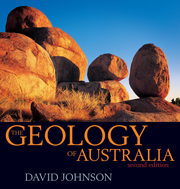Book contents
- Frontmatter
- Contents
- Map
- Preface
- Acknowledgements
- Map of main localities mentioned
- Abbreviations and units
- 1 An Australian perspective
- 2 The Earth: A geology primer
- 3 Building the core of Precambrian rocks
- 4 Warm times: Tropical corals and arid lands
- 5 Icehouse: Carboniferous and Permian glaciation
- 6 Mesozoic warming: The great inland plains and seas
- 7 Birth of modern Australia: Flowering plants, mammals and deserts
- 8 The history and evolution of life on Earth
- 9 Eastern highlands and volcanoes barely extinct
- 10 Building the continental shelf and coastlines
- 11 Great Barrier Reef
- 12 Planets, moons, meteorites and impact craters
- 13 A geological perspective on climate change
- 14 Cycles in a continental journey
- Sources and references
- Figure sources
- Index
5 - Icehouse: Carboniferous and Permian glaciation
Published online by Cambridge University Press: 05 August 2013
- Frontmatter
- Contents
- Map
- Preface
- Acknowledgements
- Map of main localities mentioned
- Abbreviations and units
- 1 An Australian perspective
- 2 The Earth: A geology primer
- 3 Building the core of Precambrian rocks
- 4 Warm times: Tropical corals and arid lands
- 5 Icehouse: Carboniferous and Permian glaciation
- 6 Mesozoic warming: The great inland plains and seas
- 7 Birth of modern Australia: Flowering plants, mammals and deserts
- 8 The history and evolution of life on Earth
- 9 Eastern highlands and volcanoes barely extinct
- 10 Building the continental shelf and coastlines
- 11 Great Barrier Reef
- 12 Planets, moons, meteorites and impact craters
- 13 A geological perspective on climate change
- 14 Cycles in a continental journey
- Sources and references
- Figure sources
- Index
Summary
The Carboniferous period is so named because of the extensive carbon-bearing coal deposits formed at that time in Europe and North America. The Northern Hemisphere climate was tropical, with vast coastal peat swamps and reefal limestones forming offshore. The Permian continued to be hot, with seasonal river systems and large salt lakes in North America and Europe.
The climate was very different for the landmasses of Gondwana, locked near the South Pole. There the climate was cold, and in some places glacial. Permian Gondwana coals in Australia, India and South Africa formed in these very different, cold-climate situations. A chain of volcanoes along eastern Australia erupted intermittently for over 20 million years.
A GLACIATED CONTINENT
The Australian landmass was glacial and actively volcanic – almost the complete opposite of the hot and dormant continent of today. A possible analogue is the continental mass of cold–climate Alaska, bordered by the Aleutian volcanic arc that passes into the deep waters of the northern Pacific Ocean.
Australia formed the northeastern part and coast of Gondwana. To the south lay Antarctica, to the southwest India – all parts of an ancient continental interior. An ocean edge still lay along the entire east coast, from Tasmania to east of Cape York. The warmth of the previous 191 million years had disappeared and the planet entered a phase of global cooling around 330 Ma ago – an icehouse. Central Gondwana became covered in an ice sheet and glaciers transported material outwards from the high mountain ranges, leaving moraines across the surrounding landscapes.
- Type
- Chapter
- Information
- The Geology of Australia , pp. 105 - 122Publisher: Cambridge University PressPrint publication year: 2009



